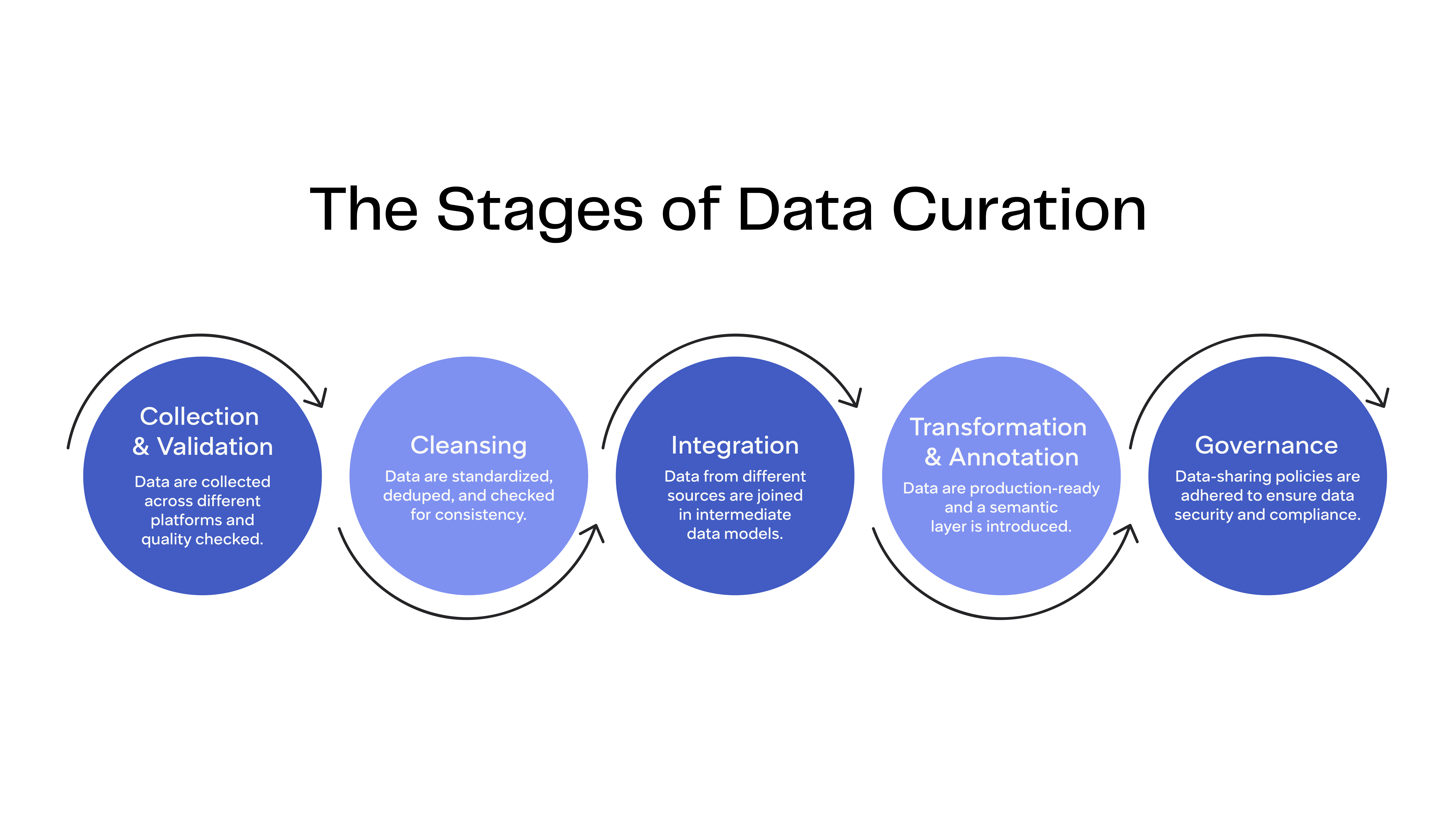Defining Your Nonprofit’s Approach to Data Curation

This blog was written in collaboration with Alexandra Wilson, Manager of Business Intelligence at Classy, and Austin McKinley, Senior Customer Lifecycle Manager at Classy.
Continuing Classy’s exploration of data’s significance in nonprofit fundraising, let’s recap what we’ve covered. Our initial post on the modern data stack highlighted prevalent challenges, including siloed systems, data quality issues, and data integration gaps. We delved into the transformative impact of modern data architecture on nonprofit operations, empowering them with advanced data management, analytics, and decision-making tools.
We then drilled into the meaning of implementing a buy vs. build approach and highlighted how the right data toolkit can save time, lower overhead, and mobilize fundraising efforts. Most recently, we explored how organizations must unite disparate business systems by establishing a single source of truth to harness the full power of donor data.
In this post, we’ll explore the benefits of data curation practices and how they add value and enhance data utility within an organization. We’ll focus on the data lifecycle and the process of transforming raw datasets into curated, digestible, and actionable reporting.
How Does Data Management Impact My Nonprofit’s Work?
In the modern nonprofit ecosystem, there’s no shortage of tools boasting data-driven approaches, self-service capabilities, and machine-learning algorithms. These tools range from web-tracking solutions for monitoring donor engagement to A/B testing platforms for refining fundraising campaigns to in-product messaging for boosting donor participation.
Yet, as we identified earlier in this content series, one of nonprofit organizations’ biggest challenges is unifying and connecting the dots between disparate data sources. While individual tools may provide valuable insights within their respective domains, a lack of integration or data curation activities can result in a fragmented or incomplete view of the donor landscape.
At Classy, we understand that data management is vital to advancing your nonprofit’s mission. Let’s explore the benefits of the data curation process and its practical applications to elevating your mission so you can confidently transform a donor data repository into powerful insights that drive innovation, enhance fundraising efforts, and increase overall impact.
5 Steps in the Data Curation Process
Data curation goes beyond joining data sources—it’s the foundation your organization sets forth from the initial collection and integration to the maintenance and updating of data. Not only does it streamline data access, but it empowers users to self-serve and become independent data analysts.
So, what does the data curation process look like?

1. Collection and Validation
Collecting and validating donor data is arguably the most crucial step in data curation. This step ensures you avoid the principle of “bad data in, bad data out.” Key aspects of this process include setting up donor data collection procedures, ensuring campaign features are measurable, and conducting quality assurance of incoming data.
2. Cleansing
Cleansing is a universal necessity in every data approach, although it can be the most tedious step in data curation. It accounts for missing or duplicate data, establishes consistency in data (such as converting donor payment currency), and identifies opportunities for errors (such as incorrect field types within a campaign).
3. Integration
Integration is the process of combining data from multiple sources to provide a comprehensive view of your donors. This can include tracking donors’ journeys in Salesforce to campaign donation performance in Google Analytics.
4. Transformation and Annotation
Transformation and annotation are the pinnacle of the data curation process. Here, raw data transforms into meaningful insights so your organization can create aggregations and begin splicing and dicing data. Applying metadata and annotations within a semantics layer makes your internal reporting even more accessible and understandable, allowing analysts to easily interpret and utilize the data in context.
5. Governance
Governance is the process of establishing and enforcing frameworks to handle and protect data appropriately internally and externally. This step is crucial for maintaining trust in the data’s integrity and usability, facilitating collaboration across different departments, and supporting strategic initiatives based on reliable data insights.
Data Curation in Action: A Look Behind the Classy Curtain
Our Data Science team’s work at Classy revolves around data modeling. Once data has been collected, cleansed, and combined across sources, our analytic storytellers begin crafting insights using data build tool (dbt). This powerful tool allows users to transform raw data with SQL or Python, collaborate seamlessly with other business users, and craft compelling narratives that illustrate the impact of charity donor engagement.
Once the data is ready and primed, we leverage Looker to build a semantic layer on top of our curated data models. Looker allows us to define consistent business logic and metrics, such as gross donation volume and average one-time donation amount, ensuring that end users work with the same definitions and understand key performance indicators.
Select Star is the last crucial component of our data curation strategy, a data cataloging tool that helps us document and share metadata on our curated data models. With this tool, we can share in-depth data lineage and usage details about our data assets. This simplifies the process for business users to find, comprehend, and access data, eliminating the need to deal with complicated data silos or depend on the specialized knowledge of our Data Science team.
Monthly Performance Snapshot
With the big picture in mind, let’s zoom in on one of our recent data curation projects and explore its impact on your organization’s engagement.
Nonprofits consistently benchmark donation performance and identify giving trends. These trends, which can be seasonal, are influenced by external factors (such as the economy or your organization’s cause category), impacting month-to-month performance.
To highlight these monthly trends, the Customer Experience and Data Science teams at Classy joined forces to develop the Monthly Performance Snapshot. This email evaluates your organization’s performance in one-time, recurring, and total gross donation volume and compares these figures monthly.
It also provides personalized recommendations that help organizations optimize conversions, such as adding digital wallets for mobile donors or embedding donation forms. Customer engagement teams can then tailor recommendations based on performance to better serve their mission.

Data curation is the driving force behind this email. Each figure comes from a complex data model aggregating the number of donations, total gross donation volume, and average recurring and one-time giving amounts over a period of time.
These metrics are filtered by custom inputs, such as payment method, and are compared monthly to determine organizational-level trends in giving behavior. We operationalize these outcomes using reverse ETL and marketing automation to improve charity administrator engagement.
Note: We aggregate this data broadly to develop these benchmarks and do not isolate or share an individual organization’s data with other nonprofits. As shown in the image above, we only share organization-level data with the respective organization.
Applying Data Curation Best Practices to Your Strategy
Data curation is a channel that connects donors to their giving causes. The data curation lifecycle, from collection and validation to integration and data governance, outlines the importance of each step in ensuring data quality and utility.
Leveraging big data and AI, The Children’s Hospital of Philadelphia has significantly improved its fundraising efforts in two key areas:
- Direct Response Campaigns: The response rate to direct fundraising appeals has increased by 85%, and the average donation size has grown by 25%.
- Major Giving: The process of moving potential major donors through the cultivation and solicitation stages has become 17% faster, and the average donation size from major donors has increased by 23%.
Most nonprofits have relied on wealth screening for decades, but wealth alone is a poor indicator of philanthropic intent. We use a three-circle Venn diagram approach: measuring attachment/engagement, assessing psychological factors, and considering wealth. We analyze interactions such as email engagement and event attendance using AI and machine learning to score attachment. Psychological profiling, based on big data, helps us understand the types of people likely to give. Wealth is considered to assign starting programs rather than determine outreach. This holistic approach builds a more effective pipeline.
Advanced tools like dbt for data modeling and Looker for creating a semantic layer allow organizations to craft and share meaningful stories from their donor data, which can enhance donor engagement. Additionally, tools like Select Star aid in data cataloging, enhancing accessibility and comprehension across the organization.
For nonprofits, the ability to streamline data curation using these technologies means improved efficiency and effectiveness in donor engagement strategies. This holistic approach not only tackles the challenges of data silos and integration but also leverages data to optimize donor interactions and boost fundraising campaigns, ensuring nonprofits can adapt and thrive in a dynamic environment.
Copy Editor: Ayanna Julien

How Your CRM and Data Warehouse Work Together


